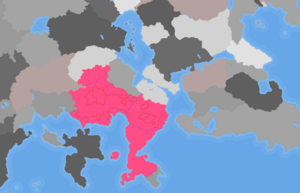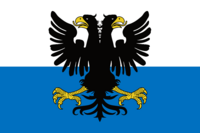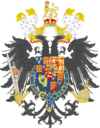Holy Gothic Empire
Holy Gothic Empire Szent Gót Birodalom (Hungarian)) Heilaofa Gotheskur Stórecht (Götaish) Heiliges Gotisches Rijch (Middle Alemanic) | |||||||||||
|---|---|---|---|---|---|---|---|---|---|---|---|
 The height of the Holy Gothic Empire (1567) in comparison with modern borders | |||||||||||
| Status | Former Territories | ||||||||||
| Religion | Catholic Church (970-1723) Protestant (1519-1723) | ||||||||||
| Government | Confederal elective monarchy | ||||||||||
| Emperor/Empress | |||||||||||
• 970-1012 | Barclay I | ||||||||||
• 1486-1499 | Adolf III | ||||||||||
• 1631-1633 | Andras I | ||||||||||
| Historical era | 970-1723 | ||||||||||
| |||||||||||
| Today part of | |||||||||||
The Holy Gothic Empire (Götaish: Heilaofa Gotheskur Stórecht, otherwise known as the Holy Empire) is a former multi-ethnic complex of territories in southern Thrismari that began in the Early Middle Ages and ended in the early 1700s just before the Thrismari Revolutionary War.
The empire was created by joining in personal union and with the imperial title the crown of the Kingdom of Lyonheimer with the Blekingi crown, particularly the Kingdom of Vesturgothia (Later Kingdom of Goteborg), as well as titles of other smaller territories such as the Duchy of Pyor and the Duchy of Pest. Soon, these kingdoms would be joined by the Kingdom of Tralka and Kingdom of Eisennau. By the end of the 14th century, the empire was still in theory composed of three major blocks – Lyonheimer, Blechingia and Greater Tralka. Later territorially only the Kingdom of Blekinge, Tralka and Lyonheimer remained, with the South Eisennauan territories lost.

